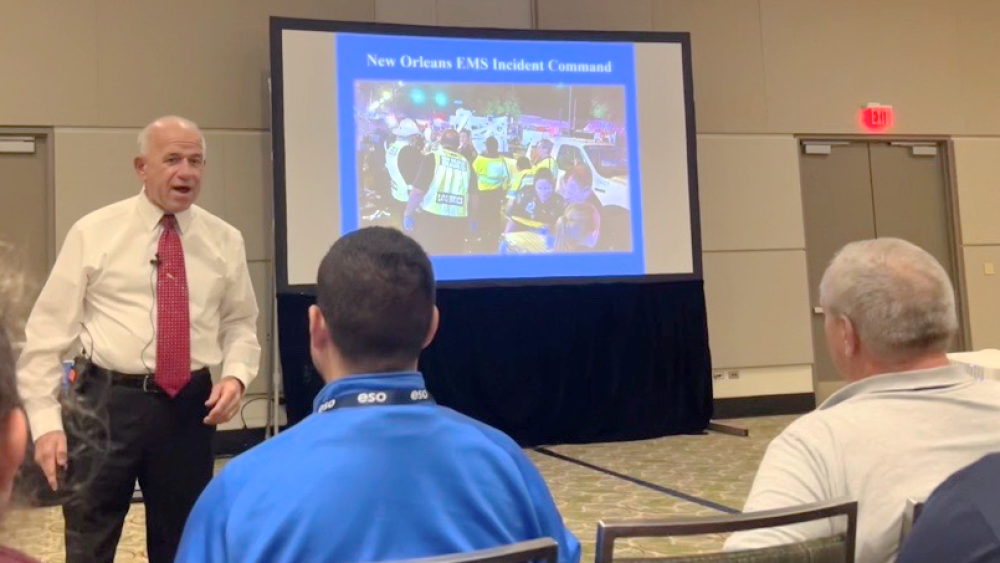ORLANDO, Fla. — Ken Bouvier, NREMT, shared his insights into the incident command system for EMS at EMS World Expo, 2022, looking at how working together can help manage incidents with less confusion, stress and challenges.
Bouvier has returned to his first foray into public safety, in a volunteer fire department, after retiring as the New Orleans EMS Deputy Chief of Operations and the Monsanto Fire Chief. He shared his stories from running ICS at Super Bowls, Mardi Gras and MCIs.
Memorable quotes on incident command
Here are some of Bouvier’s comments on the incident command system:
“We can’t go to a call and be an individual and expect a call to be easy and handled without chaos. We have to respond as a team.”
“When you see [incident command], you know it. Without it, chaos will be there. With it, chaos will be there, but there will be less of it and easier to manage.”
“In a disaster, don’t run bystanders off. Invite them to help you until you have enough personnel on scene and then swap them out.”
If your radios don’t work: “If you have a school shooting, you’re going to fail. If you have a hurricane, you’re going to fail.
Top takeaways on incident command
Bouvier polled the audience on what an incident command system is designed to do, eliciting responses like, control chaos; reduce stress; and provide order, resources, accountability, a chain of command and span of control.
Created by the U.S. Forest Service, ICS is a system responders can live with, Bouvier said. “Without it, you may lose them.”
Bouvier shared the following tips for implementing and improving incident command responses.
1. Pre-plan incidents
Pre-planning is the key to being a step ahead in an emergency. As Deputy Chief of Operations during Mardi Gras, Bouvier would choose the quietest person in the department to be his driver so he could listen to 4-5 radios at a time. People would ask him, “why so many radios?” “Why are you listening to the water channel?” His answer? Because I’m going to hear what’s happening. During Mardi Gras, people fall in the river. “I’m going to be one step ahead of them.”
Bouvier encourages systems to identify the target hazards in their districts. If you have an all-night barroom, there’s going to be a head-on collision right down the street, and you should have a plan for where to stage and land air transport, he said.
We’ve got to have a plan for just about everything, Bouvier said. “If you do not have a school shooting plan, I ask you why not? Are you in such disbelief that it is going to happen in your town?” He encouraged those who don’t have an existing plan to Google school shooting plans, pick what works for your system and write a plan.
2. Simple solutions can make the difference
Bouvier listed several low-cost solutions to IC challenges, including:
- Triage tags: They can also help track patients’ chief complaints and transport destinations.
- Glow sticks: Placing glow sticks on the vehicles in a multi-vehicle crash can prevent arriving crews from checking the same vehicles over and over. Place red, green and yellow glow sticks to indicate triaged patients, and white glow sticks to indicate those victims have already been transported.
- Accountability boards. “Haven’t you ever heard of a computer?” That was the question posed to Bouvier as he set up his peg board showing ambulance placement during Super Bowl XLVII. “Haven’t you ever heard of a computer not working when you need it to?” he responded. When the lights went out in the Superdome, guess who was in demand?
3. Saving lives
Saving lives depends on these 5 things during emergencies, according to Bouvier:
- Sound leadership. Being in charge doesn’t mean you’re the most knowledgeable person there, Bouvier cautioned, advising ICs to get their teams involved. If in 5 minutes, the emergency isn’t improving, ask someone else their ideas.
- Systematic organization. Your emergency plans cannot have names in them – they need to work whether you, or anyone else is there or not.
- Effective command. Stand firm, be a strong commander.
- Good communications. Make sure everyone knows how to work the radios.
- Accountability. Know where all your people are, all the time.














